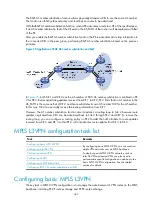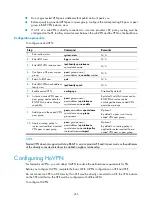
261
Step Command
Remarks
15.
Specify not to change the next
hop of a route when
advertising it to an EBGP
peer.
peer
{
group-name
|
ip-address
}
next-hop-invariable
Optional.
By default, a device uses its
address as the next hop when
advertising a route to its EBGP
peer.
16.
Specify the preference value
for the routes received from
the peer/peer group.
peer
{
group-name
|
ip-address
}
preferred-value
value
Optional.
0 by default
17.
Make BGP updates to be sent
carry no private AS numbers.
peer
{
group-name
|
ip-address
}
public-as-only
Optional.
By default, a BGP update carries
private AS numbers.
18.
Apply a routing policy to a
peer or peer group.
peer
{
group-name
|
ip-address
}
route-policy
route-policy-name
{
export
|
import
}
Optional.
By default, no routing policy is
applied to a peer or peer group.
For information about BGP routing, see
Layer 3—IP Routing Configuration Guide
.
Configuring inter-AS VPN
If the MPLS backbone on which the VPN routes rely spans multiple ASs, you need to configure inter-AS
VPN.
Three inter-AS VPN solutions are available. You can choose them as required.
Before you configure inter-AS VPN, complete the following tasks:
•
Configure an IGP for the MPLS backbones in each AS to implement IP connectivity of the backbones
in the AS
•
Configure basic MPLS for the MPLS backbones of each AS
•
Configure MPLS LDP for the MPLS backbones so that LDP LSPs can be established
•
Configure basic MPLS L3VPN for each AS
When configuring basic MPLS L3VPN for each AS, specific configurations may be required on PEs or
ASBR PEs. This depends on the inter-AS VPN solution selected.
Configuring inter-AS option A
Inter-AS option A applies to scenarios where the number of VPNs and that of VPN routes on the PEs are
relatively small. It is simple to implement.
To configure inter-AS option A, complete the following tasks:
•
Configure basic MPLS L3VPN on each AS.
•
Configure each ASBR-PE, taking the peer ASBR-PE as its CE.
In other words, configure VPN instances on PEs and ASBR PEs respectively. The VPN instances on PEs are
used to allow CEs to access the network, and those on ASBR PEs are used to access the peer ASBR PEs.
For more information, see "
."
In the inter-AS option A solution, for the same VPN, the route targets configured on the PEs must match
those configured on the ASBR-PEs in the same AS to make sure VPN routes sent by the PEs (or ASBR-PEs)
















































